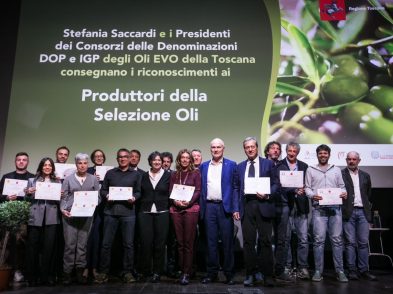Making wine is complicated. As Antonella D’Isanto, co-owner of I Balzini winery along with her husband Vincenzo, explains, that lovely potion in your glass is the fruit of labor, passion, skill, technology, and, well, fruit. Here, I share the process as she revealed it to me.
As the grapes mature on the vines, they become sweeter and more fragrant. Ripeness of wine grapes is determined according to two criteria: technical and phenolic maturation. The grapes are ready to be picked based on their ratio of sugar to acid (‘technical’ maturity) and their concentration of tasty, colorful polyphenols (antioxidants and tannins), along with their solubility (‘phenolic’ maturity).

Each winery has its own harvesting technique. At I Balzini, the bunches of grapes are hand picked and placed carefully in baskets before being transported by tractor to the cellar, where they are loaded onto a belt and passed through a machine called a destemmer, which separates the grapes from their stems. Two workers cull by hand any bunches with imperfections.
The grapes are then lightly pressed before passing by tube into temperature-controlled vats. Although all of I Balzini’s wines are blends of different grape types, each grape type is fermented separately according to its different needs during fermentation. The blend is assembled later, guided by the oenologist, whose job it is in part to determine the final composition.

In the vats, with the help of the weight of the grapes and heat, the mass begins to ferment. Alcoholic fermentation is the process through which yeast (the same stuff that makes pizza dough rise) transforms sugar (glucose) into alcohol (ethanol). There is always a percentage of natural yeast present on the grape skins and in the air of the cellar: some wineries leave nature to work its magic; others add carefully selected yeasts.
Yeasts metabolize the sugars present in the liquid, leaving alcohol and carbon dioxide as byproducts.
The ‘good stuff’ is concentrated in the grape skins. For red grapes, the main characters are the tannins (whose pleasantly astringent grip is experienced on the tongue and gums when one drinks a young Chianti); the antioxidants, which along with the tannins and other pigments are responsible for the color of the wine; and the terpenes, which lend fragrance to the wine. The longer the fermenting liquid remains in contact with the skins, the more tannins and antioxidants are extracted. In the case of I Balzini’s wines, the liquid, called mosto, or must, remains in contact with the skins for 5–6 days for simpler wines and for 10–15 days for more structured wines.
As the must begins to ferment, the skins begin to float and eventually rise to the top of the vats, condensing to form a cappello, a sort of floating cap. This cap is rich in antioxidants and polyphenols and gives color to the wine—but only if it remains in contact with a large part of the liquid. I Balzini uses a process known as délestage to remedy the situation. The liquid is pumped out from the bottom of the vat into a secondary vat and then repumped via tube to the top of the first vat, where it is showered over the cappello to break it apart and interact once again with the rest of the liquid. The higher the quality of wine, the more often the process is repeated, extracting as much of the ‘good stuff’ as possible from the cappello.

To determine when délestage should be performed, winemakers use the super-awesome Babo densimeter, which resembles a giant thermometer. When dropped into a sample of must, it either floats or sinks: if it floats, there are still sugars to burn; if it sinks, all the sugars have been converted into alcohol. A scale on the side of the densimeter indicates the ‘distance’ left to zero. At midpoint on the scale, it is time to begin délestage.
Once all of the sugars have been converted into alcohol, the wine is kept still for a few days before the liquid is separated from the vinacce (the residue and skins). The vinacce are sent to a very gentle press to recover a portion of the liquid; what remains inside the press is sent to a distillery to make grappa.
At this point, the wine rests a bit longer before it is then stabilized, clarified and bottled. Or, as in the case of some of the wines from I Balzini, it may first undergo a second fermentation known as malolactic fermentation, which utilizes friendly bacteria to convert malic acid in the wine (harsh stuff) into lactic acid (pleasant stuff), resulting in a softer, more balanced wine, before being moved to oak barrels for aging. Micropores in the wood permit the wine to slowly interact with oxygen in the atmosphere, resulting in variations in the color, aroma and flavor of the wine, while the wood itself cedes interesting flavors such as butter, vanilla, dried fruit and tobacco.
To learn more about the wines of I Balzini, go to www.ibalzini.it






